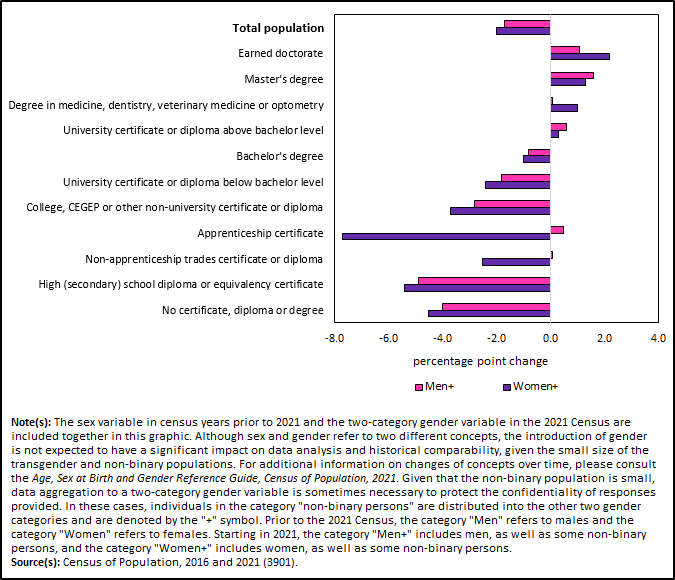Infographic 5
Change in employment rate from May 2016 to May 2021 by highest level of education and gender, for the population aged 25 to 64

Infographic description
The title of the infographic is "Change in employment rate from May 2016 to May 2021 by highest level of education and gender, for the population aged 25 to 64"
This infographic is a horizontal bar chart showing the percentage point change from May 2016 to May 2021 in the employment rate of the population aged 25 to 64, by highest level of education. Broadly speaking, the employment rate increased among those with credentials above the bachelor level in the "Women+" category and in the "Men+" category, and among those with an apprenticeship or trades certificate or diploma in the "Men+" category and decreased among all other groups.
The x-axis shows percentage point changes from -8.0 to 4.0, by increments of 2.0.
For the total population, the employment rate decreased by 1.7 percentage points among those in the "Men+" category and by 2.0 percentage points among those in the "Women+" category.
For the population with an earned doctorate, the employment rate increased by 1.1 percentage points among those in the "Men+" category and by 2.2 percentage points among those in the "Women+" category.
For the population with a master's degree, the employment rate increased by 1.6 percentage points among those in the "Men+" category and by 1.3 percentage points among those in the "Women+" category.
For the population with a degree in medicine, dentistry, veterinary medicine or optometry, the employment rate increased by 0.1 percentage points among those in the "Men+" category and by 1.0 percentage points among those in the "Women+" category.
For the population with a university certificate or diploma above bachelor level, the employment rate increased by 0.6 percentage points among those in the "Men+" category and by 0.3 percentage points among those in the "Women+" category.
For the population with a bachelor's degree, the employment rate decreased by 0.8 percentage points among those in the "Men+" category and by 1.0 percentage points among those in the "Women+" category.
For the population with a university certificate or diploma below bachelor level, the employment rate decreased by 1.8 percentage points among those in the "Men+" category and by 2.4 percentage points among those in the "Women+" category.
For the population with a college, CEGEP or other non-university certificate or diploma, the employment rate decreased by 2.8 percentage points among those in the "Men+" category and by 3.7 percentage points among those in the "Women+" category.
For the population with an apprenticeship certificate, the employment rate increased by 0.5 percentage points among those in the "Men+" category and decreased by 7.7 percentage points among those in the "Women+" category.
For the population with a non-apprenticeship trades certificate or diploma, the employment rate increased by 0.1 percentage points among those in the "Men+" category and decreased by 2.5 percentage points among those in the "Women+" category.
For the population with a high (secondary) school diploma or equivalency certificate, the employment rate decreased by 4.9 percentage points among those in the "Men+" category and by 5.4 percentage points among those in the "Women+" category.
For the population with no certificate, diploma or degree, the employment rate decreased by 4.0 percentage points among those in the "Men+" category and by 4.5 percentage points among those in the "Women+" category.
Note(s): The sex variable in census years prior to 2021 and the two-category gender variable in the 2021 Census are included together in this graphic. Although sex and gender refer to two different concepts, the introduction of gender is not expected to have a significant impact on data analysis and historical comparability, given the small size of the transgender and non-binary populations. For additional information on changes of concepts over time, please consult the
Source(s): Census of Population, 2016 and 2021 (3901).
- Date modified: